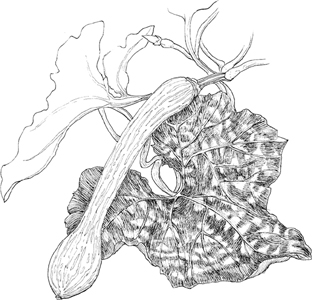
BOTANICAL NAME: Cucurbita moschata
FAMILY: Cucurbitaceae

This is a summer and winter squash that goes by many names in different parts of Italy. It is most commonly called Zucchino Rampicante (climbing zucchini; pronounced zoo-KEE-no ram-pee-KAN-tay), Tromboncino (little trombone squash), and Zucca d’Albenga (Albenga pumpkin). It is a much more recent introduction to the Italian kitchen garden than the Chioggia sea pumpkin and the various cheese pumpkins depicted in Italian Renaissance art. In fact, it is closely related to the old Canada crookneck squash (which is also the same species) and, when ripe, exhibits the same long, bowed shape and the same tan skin. Historically, the Zucchino Rampicante replaced a truly ancient vegetable called Zucca a Tromba, a variety of gourd (Lagenaria siceraria) that was harvested when very young and pale green. Zucca originally meant “gourd” in Italian, but the word is now extended to include all sorts of squash. This culinary gourd has been raised in the Mediterranean region for at least two thousand years, perhaps even longer, for ceramic copies of it have been found in archeological sites on Cyprus and in Egypt. This is the cucuzza of Sicily that is used for making zuccata, a preserve similar to candied citron that appears in many Christmas recipes from that island.
Prior to contact with the New World, Zucca a Tromba was this long, baseball bat–like gourd that furnished Italian gardeners with a source of zucchini (baby gourds). Once New World squashes were introduced in the 1500s, it was quickly discovered that the young fruits could also be used in the same manner, hence the transfer of cooking techniques and terminology. The modern Zucchino Rampicante also supplies zucchini, and remains one of the most popular of the Italian squashes raised not just for the young fruit but for its rich-flavored mature flesh as well. The young ones, about the size of the one depicted in the illustration, can be used like any zucchini. The ripe squash may be stored over the winter and employed in the innumerable pumpkin recipes that the Italians have developed around pasta, especially as stuffing in gnocchi and ravioli. Cooked with yellow tomatoes, the flavor turns fruity and makes a delightful base for soups. The diced ripe squash may be cooked with chopped fruit in syrup to make marmellata, and a tasty salad can be prepared by poaching the cubed squash in salted water and then serving it cold with chopped mint and an olive oil dressing. And do not forget the flowers. The large male flowers are perfect for stuffing and frying. They can be picked late in the morning after the bees have done their work, thus avoiding a shortfall of squashes later in the season. All in all, the Zucchino Rampicante is one of the most versatile of all the squash in the garden. If that is not enough to recommend it, consider this: it climbs, so it can be trellised or run up a fence; thus it is also a great space saver and will even provide a quick screen for an apartment terrace, since this is one squash that can be grown successfully in tubs.